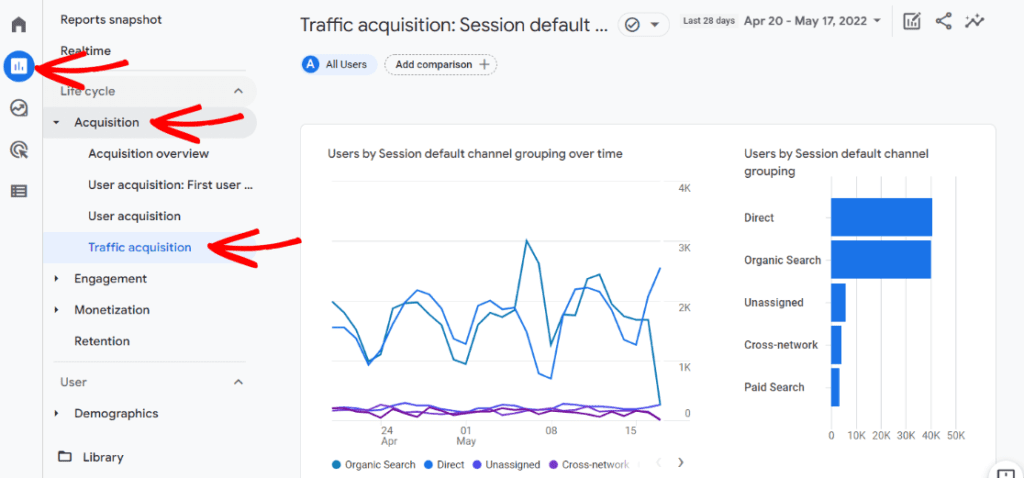Targeted Website Visitors: What It Is and How to Increase It

Do you wish to learn how to monitor website traffic using Google Analytics? Utilizing Google Analytics provides comprehensive data, revealing insights into visitor sources, duration of stay, and viewed pages. Understanding how visitors discover your site empowers strategic decisions for traffic growth. In this guide, we’ll walk you through the process of tracking website traffic with Google Analytics.
Having a strong online presence is crucial for the success of any business. One of the key factors in maximizing your online presence is driving targeted web traffic to your website. But what exactly is targeted web traffic? Targeted web traffic refers to the visitors who come to your website with a specific intent or interest related to your products or services. These are the visitors who are more likely to convert into customers or take the desired action on your site.
Understanding the importance of targeted web traffic is essential for the growth of your business. By attracting visitors who are genuinely interested in what you have to offer, you increase the chances of generating leads, making sales, and building a loyal customer base. Targeted visitors are more likely to spend time exploring your website, engaging with your content, and ultimately becoming paying customers. This means that not only will your website traffic increase, but your conversion rates will also improve.
Contents
- 1 The Benefits of Driving Traffic to Your Site
- 2 Strategies for Boosting Website Traffic
- 3 Where to Get Targeted Traffic
- 4 How to Track Website Traffic in Google Analytics
- 4.1 Access Your Google Analytics Account:
- 4.2 Select the Property:
- 4.3 Get Your Tracking Code:
- 4.4 Add Tracking Code to Your Website:
- 4.5 Verify Installation:
- 4.6 Set Up Goals:
- 4.7 Explore Audience Reports:
- 4.8 Check Acquisition Reports:
- 4.9 Analyze Behavior Reports:
- 4.10 Utilize Realtime Reports:
- 4.11 Set Up Alerts:
- 4.12 Use Custom Reports:
- 4.13 Monitor Conversions:
- 4.14 Explore User Explorer:
- 5 How To Track Your Competitor’s Website Traffic
The Benefits of Driving Traffic to Your Site
Driving traffic to your website has numerous benefits for your business. Firstly, it increases your brand visibility and awareness. When more people visit your site, they become familiar with your brand and what you have to offer. This can lead to word-of-mouth recommendations and referrals, further expanding your reach.
Secondly, driving targeted web traffic helps in building credibility and authority in your industry. When visitors see that you have a steady stream of traffic, they perceive your business as trustworthy and reliable. This can encourage them to engage with your content, share it with others, and even link back to your website, which can improve your search engine rankings.
Lastly, driving targeted web traffic allows you to gather valuable data and insights about your audience. By analyzing the behavior and preferences of your visitors, you can tailor your marketing strategies and content to better meet their needs. This helps in building stronger relationships with your audience and delivering a personalized experience that sets you apart from your competitors.
Strategies for Boosting Website Traffic
Now that we understand the importance of targeted web traffic, let’s explore some effective strategies for boosting traffic to your website:
1. Optimize Your Website for Targeted Visitors
To attract targeted web traffic, it’s crucial to optimize your website for search engines. Conduct thorough keyword research and incorporate relevant keywords into your website’s content, meta tags, and URLs. This will help search engines understand what your website is about and rank it higher in relevant search results.
Additionally, ensure that your website is user-friendly and optimized for mobile devices. A seamless user experience encourages visitors to stay longer on your site and increases the chances of conversion.
Social media platforms provide a vast opportunity to drive targeted traffic to your website. Identify the platforms where your target audience is most active and create engaging and shareable content. Use eye-catching visuals, compelling captions, and relevant hashtags to attract the attention of your audience and entice them to visit your website.
Additionally, consider running targeted advertising campaigns on social media platforms. This allows you to reach a specific audience based on demographics, interests, and behaviors, maximizing the chances of attracting visitors who are more likely to convert.
3. Collaborate with Influencers and Industry Experts
Partnering with influencers and industry experts can be a powerful way to drive targeted web traffic to your website. Identify influencers or experts who have a strong following and align with your brand values. Collaborate with them to create valuable content, such as guest blog posts, interviews, or product reviews, that will be shared with their audience. This not only exposes your brand to a larger audience but also adds credibility and authority to your business.
Where to Get Targeted Traffic
Now that we’ve discussed strategies for boosting website traffic, let’s explore some popular sources where you can get targeted traffic:
1. Search Engine Optimization (SEO)
Optimizing your website for search engines is a fundamental way to attract targeted web traffic. By ranking higher in search engine results for relevant keywords, you increase your visibility to potential visitors who are actively searching for products or services like yours.
2. Pay-Per-Click (PPC) Advertising
PPC advertising allows you to bid on keywords and display ads on search engine results pages or other websites. This enables you to target specific keywords and demographics, ensuring that your ads are seen by individuals who are more likely to be interested in your offerings.
3. Social Media Advertising
Advertising on social media platforms like Facebook, Instagram, and LinkedIn allows you to target specific demographics, interests, and behaviors. This enables you to reach a highly relevant audience and drive targeted web traffic to your website.
How to Track Website Traffic in Google Analytics
Tracking website visitors on Google Analytics involves setting up and utilizing various features to gather insightful data. Here’s a step-by-step guide:
Access Your Google Analytics Account:
Select the Property:
- In the “Admin” section, choose the property for the website you want to track.
Get Your Tracking Code:
- Under the selected property, navigate to “Tracking Info” and then “Tracking Code.”
- Copy the tracking code provided.
Add Tracking Code to Your Website:
- Paste the tracking code into the HTML of each page on your website just before the closing </head> tag.
Verify Installation:
- Go back to Google Analytics, and under “Tracking Info,” click on “Tracking Code” to verify if the status is “Receiving Data.”
Set Up Goals:
- Define specific goals for your website, such as completing a purchase, submitting a form, or spending a certain amount of time on a page.
- In the “Admin” section, under the selected property, click on “Goals” to set them up.
Explore Audience Reports:
- In the left-hand menu, navigate to “Audience” to explore various reports:
- Overview: Provides a summary of user metrics.
- Demographics: Offers insights into the age and gender of your audience.
- Interests: Shows users’ interests based on their online behavior.
Check Acquisition Reports:

- In the left-hand menu, navigate to “Acquisition” to understand how users arrive at your website:
- Channels: Shows traffic sources like organic search, direct, referral, and social.
Analyze Behavior Reports:
- Under “Behavior,” explore reports such as:
- Site Content: Shows the most popular pages on your website.
- Site Speed: Provides insights into your site’s loading times.
Utilize Realtime Reports:
- The “Realtime” section offers a live view of user activity on your site.
Set Up Alerts:
- Configure alerts to receive notifications when there are significant changes in website traffic.
Use Custom Reports:
- Create custom reports tailored to your specific needs.
Monitor Conversions:
- Check the “Conversions” section to see how well your website fulfills predefined goals.
Explore User Explorer:
- Dive into individual user journeys and interactions on your site.
How To Track Your Competitor’s Website Traffic
- SEMrush: Widely used for SEO tasks such as keyword research, competitor tracking, backlink monitoring, and organic keyword position tracking.
- Ahrefs: Offering a comprehensive suite of SEO tools similar to SEMrush, providing insights into website visitors and SEO effectiveness.
- SimilarWeb: A popular website traffic checker tool, featuring a convenient Chrome extension and additional SEO tools.
In order to continually optimize your strategies for driving targeted web traffic, it is crucial to monitor and analyze the data related to your website’s visitors. Utilize web analytics tools to track key metrics such as the number of visitors, bounce rate, conversion rate, and engagement. This data will provide insights into the effectiveness of your marketing efforts and help you identify areas for improvement.
Regularly review your website’s analytics and make data-driven decisions to refine your strategies. Experiment with different approaches, analyze the results, and make adjustments accordingly. By constantly monitoring and analyzing your website’s targeted traffic, you can ensure that your efforts are aligned with your business goals and maximize the return on your investment.
Conclusion
Maximizing your online presence through targeted web traffic is a powerful strategy for growing your business in today’s digital landscape. By understanding the importance of targeted visitors, implementing effective strategies for driving traffic, and continuously monitoring and analyzing your efforts, you can ensure that your website business gets as much traffic as possible. Remember, targeted web traffic not only increases your visibility and credibility but also significantly enhances your chances of converting visitors into loyal customers. Embrace the power of targeted web traffic and unlock the full potential of your online presence.
CTA: Ready to take your online presence to the next level? Contact us today to discuss how we can help you drive targeted web traffic to your website and achieve your business goals.
